The travel trailer virgins are, well, no longer virgins having one five mile two night trip under their belts. Now it’s time for the first trip of any distance, almost 90 miles to Rend Lake in southern Illinois from our southeast Missouri home. This is the report on how things went and what new stuff we learned.
First, we picked the rolling motel room up at its indoor storage home where we keep it when not on the road. The balls on telescoping rods we bought as a hitching guide worked well. After a couple of very minor adjustments the trailer coupler (Dave looked up the nomenclature and the trailer coupler is the thing on the end of the trailer you drop down onto the ball of the hitch) was directly over the ball and we could hook the Yukon and the travel trailer together. This process was made a little more complicated because it was under the watchful eyes of the guys that were doing some construction on the storage units and Dave, a one-time construction guy himself, knows how unforgiving they can be if mistakes are made. But we got it hooked up.
Hitch down until it’s just on the ball. Load leveler bars attached to the hitch and now count up 5 links and lock it to the trailer frame. Same thing on the other side. That done, retract the trailer foot and you’re all hooked up.
Did the final walk around.
Shore power unhooked, and the cable stowed?
Check.
Chocks pulled?
Check.
All hatches closed and locked?
Check.
Slide in?
Check.
Door locked, and hand rail folded?
Check.
Safety chains crossed and attached?
Check.
Trailer lights plugged in?
Check.
Extended mirrors attached and adjusted?
Check.
Okay, let’s roll this bad boy.
Pam: “Did you check the air in all of the tires?”
Dave: “No.” Dave pulls over in the parking lot of the RV storage unit and dutifully checks the RV Tires. Pam: did you check the truck tires? No they were checked at the last oil change. Pam: rolls eyes and bubble above head reads “with temperatures that hover at 90-95 degrees and drop to 60-65 degrees at night she knows the air pressure can expand and contract.
Pam – “did you bring your trailer keys?” He had already asked me for mine……
Dave – ((sigh)) “of course not.”
Pam: we need to go by the house on the way out of town and get the second set “just in case”.
So, the first leg of the odyssey was changed to a stop by the house, only a mile or so away from the storage place but on NARROW residential streets.
We made it, no problem, just being careful with a 172-foot trailer behind.
Got the keys.
House relocked, alarm set, arrangements made to feed the stay-at-home cats and pick up the newspapers.
Google maps on the cellphone on the dashboard with the little blue triangle showing the way.
Okay, here we go.
Right turn onto Broadway.
About five blocks to Sprigg Street.
Right turn onto Sprigg.
NOOOOOOOOOOOOOO!
The first 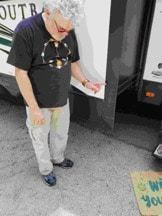
As we were traveling down Sprigg street, blissfully unaware that our new home was now marred – –
Pam – “We didn’t check the lights.”
Dave – “Nope, we didn’t. They should be all right.”
Pam – “We NEED to check the lights.”
Dave – “You’re right, we’ll find a place to pull over.”
Across the Mississippi River and pulled into the local strip club which has a BIG parking lot. The bride gets out and we do the lights, brakes, turn signals check and everything is okay.
Rolling again.
The trip itself involved travel on two lane state highways, passing through a couple of small towns, surviving a traffic circle, and then onto the Interstate highway.
A couple of miles to the first stop, left turn, and then a steady 50 miles per hour cruise for about 10 miles.
Dave is still a bit worried. The Yukon has the trailer package, and the button on the gearshift lever has been pushed with “Tow/Haul” showing on the dash. It IS, though, the small V-8 (the Vortec 5300 or 5.3 liters, what Dave still thinks of as 325 cubic inches) so he’s worried. Besides that, the Yukon has over 190,000 miles on the clock. Easy Interstate miles mostly but still, that’s a LOT of miles.
As it turned out, the worry was needless. All gauges stayed exactly where they were without the trailer.
This is a BIG unit though, and it takes a while to get used to that secondary bounce whenever you run over a bump in the road. And these are state maintained roads so there are plenty of bumps. Up some fairly steep hills though, and through town, the Yukon had no problem pulling the grades or stopping and starting.
It did take some minor adjustments on the electric brake control to level things out. At first it felt like the trailer was trying to kill us by pushing us through the intersection. Then, with an over correction, you could feel that little bounce when the Yukon brakes were released and the trailer sort of bumped forward when the trailer brakes released. A few adjustments, though, and we hit the sweet spot when it wasn’t pushing OR dragging too hard.
Then came the big test.
How would everything work on the Interstate.
The Yukon accelerated adequately up the on ramp and came up to a 55 mph cruise handily.
Dave watching gauges VERY carefully now. And everything looks good.
Then the first semi passed us at about a 15 or 20 mph closing speed.
We survived, but for you other novices, you WILL feel every one of those semis that pass you. That big bow wave of air they push ahead of them hits that big sail of a wall you’re dragging along behind you trying to push it to the right and then, as it passes, that vortex behind it tries to pull your trailer to the left. After the first few Dave, who was driving, finally got used to it and realized it wasn’t actually going to blow them off the road, but he did trade his normal three fingers casually laying on the bottom of the steering wheel for a standard 10 o’clock 2 o’clock grip on the wheel.
Then the wind came up. Not the buffeting from the semis, but nature’s own wind, and once again that big sail behind us was very much aware of it. Both Pam and Dave felt the little shimmy and following what had been learned from reading, along with plain old self-preservation and common sense, reduced the speed from a steady 55 to about 51 and that made a difference.
Dave wanted to try the cruise control because he thinks (actually, he knows damn well) that it keeps a much steadier cruising speed than his right foot does.
It worked fine.
The biggest thing he noticed was that the “Tow/Haul” function does adjust the shift points on the transmission quite a bit, holding in lower gears longer than he’s used to in the Yukon, presumably to keep the engine up in its power band better.
The summary on that leg of the trip is this – –
- Even in the badly rutted cow paths that Illinois laughingly calls its Interstate highways, the trailer followed the Yukon just like it was supposed to.
- No, semi-trailers will not blow you off the road although you will be aware of every one of them.
- Side wind has a definite impact when you’re hauling a 97 foot trailer.
- Be VERY careful with those right turns or you’ll get dings.
Arrival and Set-up
Google maps found the campground without a hitch. The very polite and friendly guy at the entrance gate issued us our dayglo green tag for the mirror and yellow card for the marker pole. We drove down and found the proper spot. Occupied by a boat.
The folks camping across the street (road? What DO you call them in a campground?) had parked their boat in our spot but very politely moved it. We were happy that politeness and friendliness seemed to be the order of the day.
Now, for the first real test, backing a 92 foot trailer that’s 8 feet wide onto a pad that’s 8 feet and 1 inch wide. Well, okay, maybe it’s more like 12 feet wide.
Pam exits the vehicle, standing on the right at the rear of the pad, clearly visible in the mirror.
Hand on the bottom of the wheel.
Move hand to the right to move trailer to the right.
Okay, that worked, now where’s the damn pad in the mirror.
Okay, there’s the pad and the wheels.
Steering wheel straight now. Pull forward just a few feet to get everything lined up.
Back.
SLOWLY.
Pam waving back and then clenched fist.
We’re THERE!
Dave gets out and we look. Okay, a little crooked.
Back in the Yukon, pull forward a few feet again.
Hand on the bottom of the wheel. Need to turn the trailer just a bit to the left now. Hand to the left.
Back.
SLOWLY.
Pam’s fist clenched again.
Gearshift in Park.
Rocky style jumping up and down, hands raised like he’s at the top of the Philadelphia Museum of Art stairs (not really but that’s how it felt).
Okay, wheel chocks first (Pam has read too many stories about trailers deciding to leave their designated spots to forget this step).
Put the little T-shaped level on the hitch frame. We’re okay side to side but the front is WAY high.
Now to unhook. Which actually turned out to be pretty simple. Just pull the pin on the trailer coupler and pull the locking mechanism back out of the way, lower the foot until the weight is off of the hitch, pull the pins on the load leveler systems and release the chains, remove those HEAVY bars and set them aside for later storage, unhook the safety chains, unhook the trailer light/brake cable, and then lower the foot to raise the trailer coupler until it’s off of the ball. In our case it took shifting the Yukon into neutral to let the coupler release completely, but that’s it.
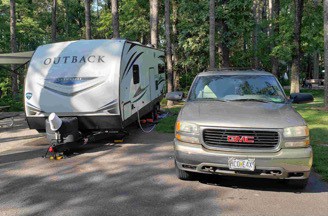
Next step is shore power, so the ref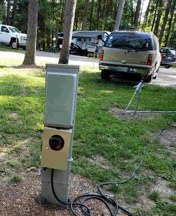
Where did he leave those gloves. Actual Mechanix branded from Lowe’s. Ahhhh, there they are in the basement. That should save wear and tear on delicate fingers.
Back to leveling. The bubble says we’re okay side to side but high at the front. No problem, just push the button and the foot starts retracting lowering the front.
And retracting.
And retracting.
Finally, some movement of the bubble.
And retracting.
And retracting.
All of the way to the stop.
In the end we’ll have to settle for being a smidgeon of a bubble off front to back. That turned out to be undetectable in real life.
Being mortified at the thought of the rolling motel room, well, rolling, the next step was the fancy new between the wheel locks 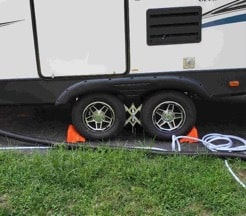
White hose to get water in. Filter, regulator, hose, in that order and hooked up. Turned on the water and it leaked everywhere. Okay. Turned off the water and tightened all fittings. Water back on, no leaks.
Now the sewer hose. Pop the little cap on the square bumper and pull out the hose. Oh crap ((chuckles)). Where are those rubber gloves? Oh well, too late now.
It turned out to be quite a puzzle remembering, well, okay, figuring out how the ends hooked to the tube and then to the trailer outlet and then to the sewer dump.
LESSON ONE
Pay attention to where the connection to the sewer is. In this case, the pipe sticking out of the ground was about 14’ 11” from the outlet at the bottom of the trailer. With a 15 foot hose, well, you can see the problem.
Finally got the system figured out and that part hooked up.
Then the Yukon unloaded. Remember, this is our first longish trip and we’re still setting up our new portable home, but Dave is praying, fervently, that this will end the major hauling (and buying) involved.
Pam is the queen of organization and day one and a good bit of day two are spend doing just that.
We had forgotten, of all things, ice, and our little table top ice maker does a good job, but it DOES take some time, so we ran into town for ice and on the way got Subway sandwiches. Our dining room table worked well and so we ate and settled in for a night of TV and relaxation.
LESSON TWO
Make sure your cell phone data plan has plenty of gigabytes. The campground we were at had no local Wi-Fi, so we turned on the mobile hotspot function on the cell phone (Dave’s brand new, state of the art Samsung Galaxy S9). It worked just as advertised. Simply go into “settings” and find connectivity and turn on the mobile hotspot button. Then we synched it to the Roku device. Synched just as it should. We went to Netflix and told it to load something or other (don’t remember what) and it took forever for anything to happen and then, when it did start playing, after a few seconds gave us “loading” with that bar slowly filling across the screen. After a few minutes of that we gave up. Pam watched some Survivor on her iPad (it was already downloaded) and Dave read. It had been a long day.
The next day Dave checked with the AT&T web site, having miraculously saved the necessary account usernames and passwords to allow such a thing, and found that we had already used our programmed 6 gigabytes of data for the month. Since he had (miraculously) managed to have all identifiers handy, he changed to a 20 gigabyte program. That was done right away and from that point on we had high speed Wi-Fi that rivaled what we have at the house through our cable system. This was much better performance than we had anticipated.
It seems that what happened was that AT&T, and we assume all other providers of such services, had previously had programs that instituted an extra charge if authorized program usage levels were exceeded. The courts put a stop to that system so now, if you exceed your allocation, you are bumped to a low speed access. If you’re trying to watch a movie or pretty much anything that required high speed, you’re out of luck. The new 20 gigabyte program is about $50 a month more but, so far anyway, it is providing us with internet service and speed as good as what we’re used to at home with our cable system.
LESSON THREE
Try it before you bring it. We had purchased the Blackstone DASH grill, giving Pam a flat top to cook on in a nice light system to boot. Day two morning came, and Dave started setting up the grill to collect the promised big breakfast. Setting up the portable grill wasn’t a problem although it did take a bit of thinking. Legs had to be screwed together and then installed. The handle that extends so you can roll the grill along behind you, like that luggage you see at airports, had to be extended to serve as the third leg of the tripod base. Then the regulator needed to be screwed into the system and the propane tank hooked up.
Uh oh.
Where’s the regulator?
No regulator to be found.
Since this was our first time using it we know we didn’t lose the damn thing.
Okay, off to town to get a regulator, surely Wal-Mart has such things and surely there is a standard.
No and no.
The Wal-Mart guy recommended Ace so, following the ever-trustworthy Sherpa guide Dr. Google, Dave’s off to Ace. No, they aren’t standard. But this connector and this regulator and this hose should work nicely. $52.74 on the credit card and back to the trailer after a stop at McDonald’s for sausage and egg McMuffins.
Of course, it didn’t fit.
Back to Ace, this time with grill along eliminating any guesswork.
Nope, they don’t have anything that’ll work.
Back in the trailer, on the phone with the Blackstone lady, Melissa as I recall. She was very nice, very apologetic, and assured me that they would have a new regulator to us on the first UPS truck.
LESSON FOUR
You REALLY want the capability to do your grilling outdoors.
With our grill option foreclosed, and still needing to eat, Pam broke out the cooking utensils and we (okay, she) gave the indoor stove a whirl. It worked just fine although the oven part wouldn’t handle much more than a loaf of bread. The thing is, three burners going in so few cubic feet REALLY heated things up. She was cooking brats and beans in our tiny little camping cookware. Our oversize air conditioner kept up, but you really want to have the capability of doing your cooking outside as the heat caused the smoke alarm to go off. This freaked the 6 year old schnauzer “Baxter” out, causing him to have the shakes and be panting like he had run a marathon. So, Pam sends Dave and the two schnauzers outside to get away from the heat and frankly give her more room and less radiant body heat to heat up the TT. An hour later and with grease splattered everywhere within 10 inches of the gas stove top, dinner of brats, beans, sliced fresh tomatoes and fresh cantaloupe was served.
LESSON FIVE
Make a checklist. Remember the needed extra stop for keys, resulting in our first ding, and then the follow-up stop to check lights. Well, add to that the forgotten undershorts (him) and forgotten eggs (her).
LESSON SIX
Use plenty of water when you flush. If you’re like us, new at this stuff, you’re concerned about filling the tank. On this trip, with three days and associated bathroom usage, our gauge finally showed the one-third level. This LESSON got highlighted when the water stopped flowing. There was a main break and all service to our state park campground was lost, instantly. That means we were unable to use the high-pressure flusher system on our sewer tube connector to finish our tank dumping and had to rely on the grey water to do any follow up flushing. We’ll report on how well that worked when we take the next trip in three weeks.
And then there are the things beyond your control. The travel trailer came stock with a nice stereo system including outside speakers and an associated 50” hi definition TV, all by Furrion which seems to be a big name in electronics made for campers. One would assume, since these are items made with the shaking involved in being in a trailer in mind, that they would be heavy duty throughout. Think about those lightbulbs designed for use in ceiling fans and you’ll get the idea.
The stereo, once Pam figured out how to make it work, wasn’t bad. It picked up FM stations well and played DVDs. We didn’t have any music CDs with us but assume they will work too. The problem with the sound system part is that the moron who designed the remote control had the idiotic idea that black letters in small type on a grey unit was a good idea. Well, it wasn’t. Neither Dave’s 70-year-old eyes nor Pam’s 60-year-old eyes could make heads nor tails of the buttons without a very bright auxiliary light. Then, when adequate auxiliary light was available, the shiny surface made a glare almost impossible to see through. It worked okay once we figured it out (okay, once Pam figured it out, her being the one with the patience to work her way through the 512-page instruction book) but those illegible letters and numbers are still in the running for Stupidest Idea of the Year.
Which brings us to other things we couldn’t anticipate.
Pam – “Dave, come in here.”
Dave – “Why?”
Pam – “The TV just went ‘pop,’ and it won’t come on.”
Dave – “What?”
Pam (with audible eye roll) – “The TV just went ‘pop,’ and it won’t come on.”
Which is exactly what had happened. Dave followed up with the normal diagnostics (meaning he unplugged it and plugged it back in). The electric outlet was hot, we knew since there is a power strip plugged into it and THAT was lit up. In desperation Dave got out the 912-page manual, found the trouble shooting section and under “TV won’t come on” found all of the things he had already done except “unplug unit for an hour and try again.” So, he did. No luck. Still won’t come on.
A call to the dealer, therefore, was in order to see if they had any ideas. No luck again. Just the things we had already tried. The trailer goes back to the dealer on the way home and we’ll take it to the storage place once we have a TV that works again. Fortunately, the 24” TV in the bedroom worked and once the Amazon Firestick was linked to the aforementioned mobile hotspot on the newly upgraded AT&T program we could watch as many episodes of Orange is the New Black as we wanted to.
Among the unanticipated and unexpected problems was the loss of water in the entire RV camp ground. Fortunately, morning bathroom breaks had been made (by Dave anyway) but since we are NOT campers, but rather dwellers in our mobile motel room, it meant we would just pack up and head home early rather than waiting to hit the 4:00 p.m. checkout time.
Closing observations on our 4 day (almost) adventure – –
Dave got the hammock he got for his anniversary set up and it worked nicely. A two-hour nap on the second full day attests to its comfort.
The air conditioner works well, keeping the 88-degree, 99 percent humidity days at bay.
Dave mounted a bar across the screen door to allow for easier closing. That night we realized it was at exactly the height to hit the handle on the door to the bedroom reducing already extremely limited hallway space. The next day he remounted it using the old top holes as the new bottom holes. Problem solved or anyway it will be when a dab from the Testers’ Paint Stick hides the old bottom holes.
The trip home was the trip out in reverse. We had a bit of a scare when the Yukon got hot while we were doing the leave the campground process and the car was idling to keep the air conditioner running and the wife and dogs happy. A few seconds of movement, though, and the air over the radiator worked and the needle dropped right down to the middle of the gauge where it belongs, even when it’s NOT hauling three tons.
Dave neglects to tell all of you that “the wife,” Pam, who has never backed anything but the vehicle itself, backed up that Yukon right to the “magnetic hitch balls” like there was nothing to it. I was very proud of myself. Job done by a girl no less! (Dave note: She did. Now if I can just get her into the driver’s seat then I can get back to my normal routine of sleeping on trips.)
There was a bit of swaying and shimmying. A quick stop at the Quik Stop to check all hook ups and make sure the ball and trailer coupler were still enjoying a deep and loving connection. They were.
Hmmmmmm.
Checked the sway bar and put another half turn tightness on the brake pads. Dave thinking “what else COULD it be.” That pretty much fixed the problem but the whole rig, Yukon and 86 foot travel trailer, ARE very subject to wind and semis will blow them around. By and large, though, even on the badly rutted goat paths that serve as state highways in southern Illinois, and we won’t even discuss the Interstate highways, the trailer trailered just like it was supposed to.
We did see an absolutely brilliant idea for a leveling system that Dave fully intends to plagiarize. The guy in the next spot needed to level a little side to side. He had made one leveling board using what looked to be a 2X12 board, beveled on one end, with two more 2X12s, these cut shorter and beveled at both ends and much shorter, attached (screwed and glued when Dave does his) to the longer main board. The distance between the shorter boards was the distance between the two wheels on the trailer so that he could back over the first of the shorter boards and then have both wheels on the first (longer) board or back another foot and have both wheels on the second (shorter) boards allowing for a total lify of 1 ¾ to 3 ½ inches (a nominal 2 X 12 being, actually, about an inch and three quarters. Dave’s between-adventures project is going to be to make one of these. Pictures will be included when I write that one up.
Speaking of the next adventure, we’ll be heading for HuzzahValley Resort in western Missouri next month. That’s another trip of about 100 miles but this time no stretches of Interstate. Two lane Missouri state highways through the Ozarks all the way. Maybe this time the water will keep flowing. Wish us luck!

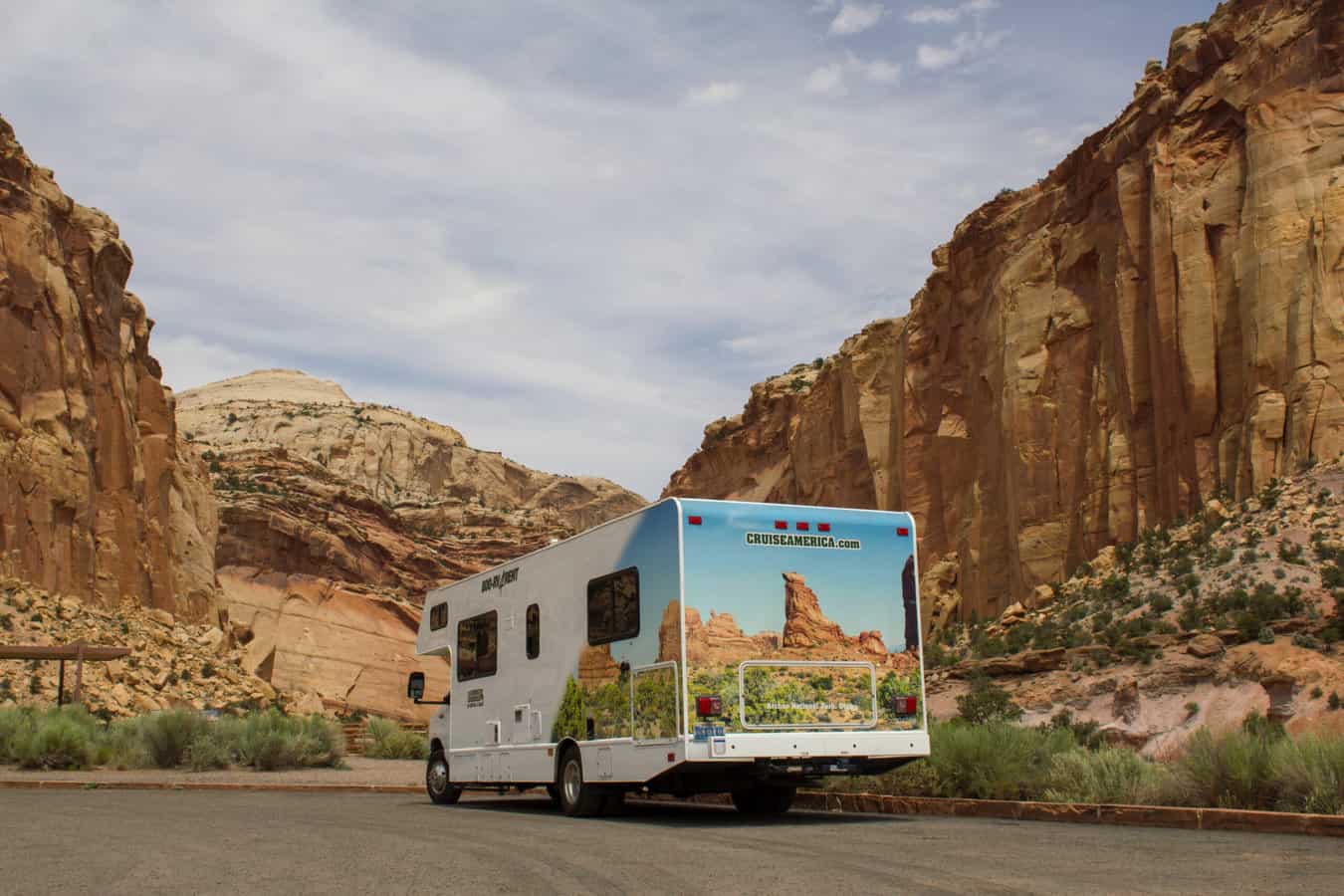

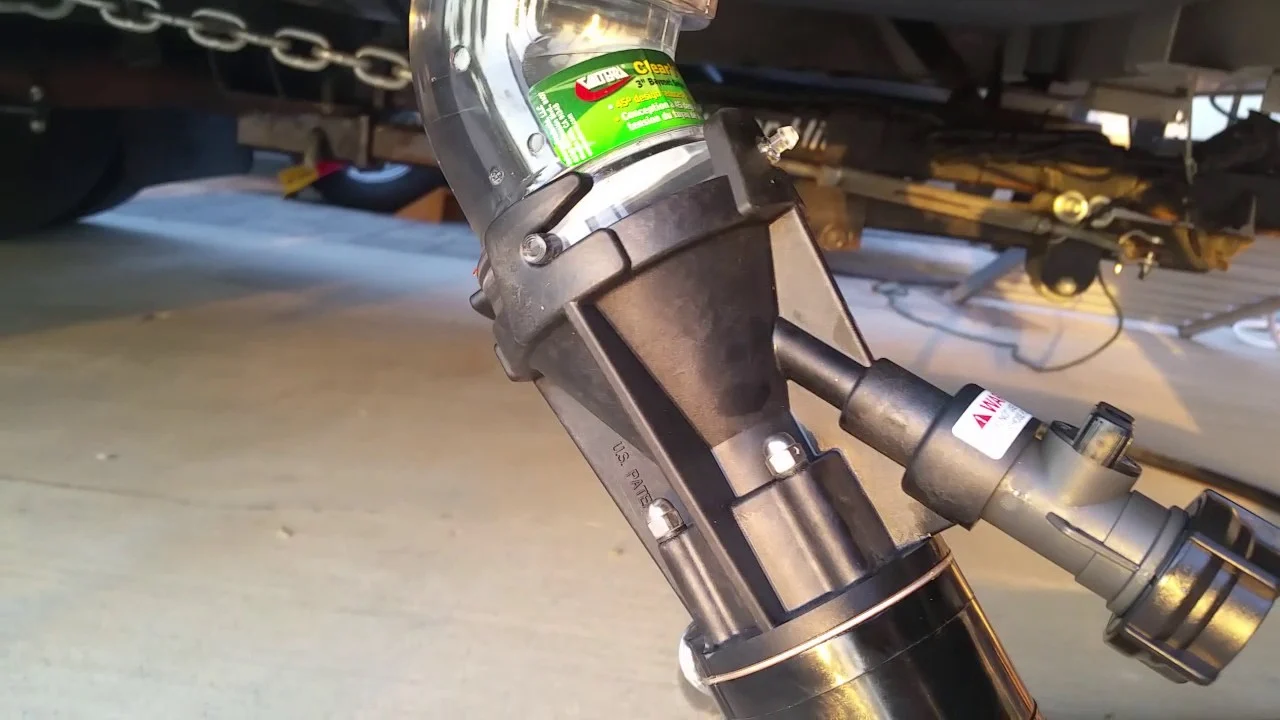
HI Pam and Dave!
We haven’t embarked on our “de-virginizing” trip yet. We are still getting the stuff together to make our first journey to Abilene State Park (about 30 miles away). We brought home our Rockwood Mini-Lite about a month ago. I never realized there was so much to buy prior to our maiden voyage lol until I started researching THAT too. I enjoyed the humorous, yet educational, recounting of your first trip. We will make sure we have ALL our keys when we leave the house the FIRST time LOL! Best of Luck for your next adventure and I am looking forward to seeing pictures of that leveling system!
Mark&Sandy